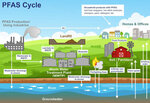


“PFAS,” also called “forever chemicals,” is a new challenge facing public water in cities and towns across the country. Manchester has been testing for these chemicals at the Lincoln Street Well and at the town’s other water resource, Gravely Pond, for two years. Chuck Dam, director of Manchester’s Dept. of Public Works, oversees testing and treatment of our water system and a past president of the Massachusetts Municipal Water Association. Here’s the update.
Q: Can you give a quick/recent recap of the Town water supply concerning PFAS?
A: We started PFAS testing before DEP required it for our water system size in 2021. Because of variance in testing results (due to the extreme sensitivity of testing to parts per trillion (ppt); for context that is the equivalent of 1 second over 31,709 years) we elected to send separate samples to both of the state’s certified labs in our area.
Our results, which are reported monthly to DEP, have always been below the current Maximum Contaminant Limit (MCL) threshold at both sources.

What are the current limits for PFAS and what are potential changes?
The current MCL was set by Massachusetts DEP at 20ppt (sum of 6 individual PFAS compounds). EPA has currently proposed new limits of 4 ppt for 2 individual PFAS compounds (PFOS and PFOA) and another factor for other PFAS compounds.
What are the Town’s plans to address any changes to PFAS limits?
We already did a study on treatment options (and cost) at the Lincoln Street Well (LSW). We are currently reviewing options for our Water Treatment Plant (WTP) at Gravely Pond in light of the potential changes proposed by EPA. Part of this new analysis is whether it is potentially cheaper to pump the LSW water to Gravely Pond (via a new pipe) and treat all potable water at the WTP. This evaluation needs to account for the capital costs as well as ongoing O&M costs, which is our current task with our consultant. Our next step will be to test various types of filter media with our specific water chemistry (bench-scale and pilot scale testing) to ensure we get the best possible treatment with our specific water and existing treatment.
There are pros and cons to doing combined treatment vs separate treatment systems at the LSW and WTP. One major consideration for separate treatment systems is redundancy; in the last 3 years, there have been instances where either the WTP was offline to facilitate planned work or the LSW was offline to facilitate emergency work; these offline instances ranged from a few days up to over a month. Being able to provide water to residents during these times was only possible because water could still be provided from the other facility that was still online.
What are the potential costs?
No way around it. They are significant. In 2022 the potential upgrades at LSW alone were estimated at $9.7 million. Currently the approach at Gravely Pond is roughly $16.4 million. The cost of a pipe from LSW to the WTP will be $10-11 million. These costs may be offset somewhat by the class action lawsuit against PFAS manufacturers as well as state and federal grants (or zero interest loans) but the amounts of any of these awards is yet to be determined. Note, however, that these are planning level costs. Nothing is certain with respect to costs until we advance the design and go through the bidding process.
Are there any other treatment technologies to address this issue?
For the purposes of drinking water treatment, the available options are granular activated carbon (GAC), anion exchange and membranes (each discussed in more detail in the LSW report on the town website). Because remediation and treatment are part of an emerging industry, there is a lot of research and development going into it (as well as into things that turn out to be non-viable). While some things appear to be promising, it is unlikely any of them will be approved for use in drinking water, at scale, in the time frame that the Town would need approval from DEP for a proposed treatment system. Therefore, we are not seriously considering them to meet our treatment goals with future compliance requirements.
Given the cost of implementing these improvements, should we consider abandoning the well on Lincoln Street and/or finding a new water source?
Absolutely not. There are many layers to this answer. Even at these costs, it would not be advisable to abandon a viable water source and lose the redundancy our two sources provide. Folks may not know (which is a good thing) that we constantly operate our water system to maximize our resiliency and water quality while minimizing service disruption. Last summer for instance we had a very dry summer and although we implemented water restrictions in response to the state drought declaration, our water supply was never really in jeopardy of not being able to respond to system demands. We monitor things such as pond level, draw down in the well, as well as other water quality parameters to inform decisions on which source is used when and/or more often. We also have occasional downtime for maintenance as well as unforeseen issues out of our control (such as pump failures). LSW also provides a boost to system pressures on the eastern side (opposite from the WTP) of town as well as additional fire protection. Beyond that we have external factors like other potential threats (emerging containments) and climate change (prolonged drought) that could pose a threat to our sources in the future so maintaining more than one source, in separate aquifers as the Town currently has, seems to be a prudent strategy at this time for long term resiliency.
New sources would take a considerable amount of time to acquire and develop, likely cost millions of dollars in their own right, and are just as likely to require treatment for things like PFAS. It would be extremely premature to abandon the LSW until an additional source (or two) were available to come online (fully approved and built). The time it would take to go through this process would mean LSW would require treatment anyway to remain active (absent this source we would be extremely vulnerable).
In short, a new source, not a viable solution on the current timeline to adequately respond to PFAS regulations.
Will we have to shut down either water source anyway?
Currently we do not think we will need to shut down either water source for an extended duration. All current regulations and future drafts read that we will have a multiyear period in which to come into compliance with whatever the final MCL is. If that changes, we may need to implement conservation measures like outdoor water use restrictions. We also have the ability to perform much of the work during off peak times of year, so disruption would go largely unnoticed by users.
After treatment is installed, how much PFAS will be in the water?
The good news is all of the approved treatment processes under consideration should remove PFAS down to a non-detect limit with today’s current testing.
Will there be other treatment benefits?
If we install GAC at LSW we will also install iron and manganese removal system (greensand media) which will have a positive impact on water quality. There may be other benefits we observe that will not be evident until we select a media and do the required bench-scale and pilot testing.
Why doesn’t the town just buy residents bottled water or provide in-home treatment?
First- the regulations are based on point of entry into the distribution system (water as it leaves the plant or well). In-home treatment will not be adequate for meeting the regulations.
Second- there would be considerable O&M and testing requirements for in home solution that we otherwise do at our treatment facilities. It would not be financially viable for the town to make this type of investment only to continue with treatment options as described above.
Bottled water would also be a costly alternative and there is no way of knowing the amount of PFAS in bottled water short of testing at the certified labs which is not currently required for bottled water (not regulated by EPA).
Do you recommend in-home filters or treatment?
We currently haven’t vetted any in home treatment systems and don’t have one to recommend. Everyone’s situation is different but unless you are doing a very vigorous analysis and subsequent testing of potential in home solutions, it is likely you will not get to a 24-7, zero pfas solution. Some carbon filters may work for a certain period but will require constant changing or regeneration of the media. Reverse osmosis will work but will have corresponding increased energy consumption, increased water consumption (RO has a waste stream of water not for consumption) and other required maintenance.
Compounding this issue is a lot of marketing/false advertising regarding efficacy of in-home solutions. We have tried/tested one pitcher/filter combo along with our routine monthly testing and the results were inconclusive (not effective). Please use all due diligence if you elect to install one of these solutions in your own house.
How does conservation of water and/or rates play into this?
The proposed rate structure in front of the Select Board was only intended to encourage conservation, targeted mostly at high users, which tend to be ones that use potable water supply for irrigating lawns. It was also meant to be overall revenue neutral compared to previous years.
Whether or not the rates get implemented or the town even sees a corresponding dip in demand remains to be seen at the juncture. It also varies a lot year to year depending on several factors. With or without the rates and/or reduction in demand there is very little to no chance (mostly no chance in my opinion) it will affect our overall requirement to treat for PFAS or the likelihood that we abandon one or the other of our sources (we won’t), for all the reasons stated above.
Are there any other benefits of conservation with respect to PFAS?
Conserving water at some scale will ensure that we do not overly draw down LSW or unnecessarily lower the level of Gravely Pond. When the pond is full and the ground water at LSW is high we are less likely to draw in contaminants from the surrounding watershed. Individual conservation across the entire town could add up in this respect and being good stewards with our water (or any resource) is everyone’s responsibility. For our “normal” precipitation and consumption patterns the Town has been fine in this regard and only some random situations have required curbing non-essential use. That is not to say today’s “normal” will always be the status quo.
For more info visit the dedicated PFAS page on the Town’s website or if there are additional questions, please reach out to DPW.